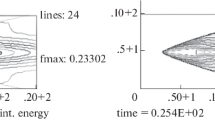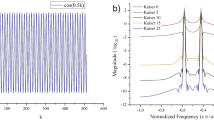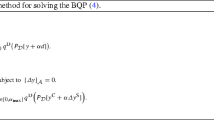Abstract
Most iterative techniques for solving the symmetric positive-definite systemAx=b involve approximating the matrixA by another symmetric positive-definite matrixM and then solving a system of the formMz=d at each iteration. On a vector machine such as the CDC-STAR-100, the solution of this new system can be very time consuming. If, however, an approximationM −1 can be given toA −1, the solutionz=M −1 d can be computed rapidly by matrix multiplication, a fast operation on the STAR. Approximations using the Neumann expansion of the inverse ofA give reasonable forms forM −1 and are presented. Computational results using the conjugate gradient method for the “5-point” matrixA are given.
Zusammenfassung
Die meisten iterativen Methoden zur Lösung des symmetrischen positiv-definitiven SystemsAx=b enthalten die Näherung der MatrixA durch eine andere symmetrische positiv-definitive MatrixM und anschließend daran die Lösung eines Systems der ArtMz=d bei jeder Wiederholung. Auf einer Vektor-Maschine wie der CDC-STAR-100 kann die Lösung dieses neuen Systems sehr zeitraubend sein. Wenn jedoch eine NäherungM −1 zuA −1 gegeben werden kann, so kann die Lösungz=M −1 d sehr schnell durch Matrixmultiplikation errechnet werden. Diese Kalkulation kann auf dem STAR schnell ausgeführt werden. Näherungen, bei denen die Neumann-Entwicklung der Inversen vonA verwendet wird, ergeben angemessene Ausdrücke fürM −1. Diese Ausdrücke sind angeführt. Die mit Hilfe der Konjugierten-Gradienten-Methode errechneten Resultate für die „5-Punk”-MatrixA sind angegeben.
Similar content being viewed by others
References
Cline, A. K.: Several observations on the use of conjugate gradient Methods. ICASE, NASA Langley Research Center (Hampton, Va.).
Concus, P., Golub, G. H., O'Leary, D. P.: A generalized conjugate gradient method for the numerical solution of elliptic partial differential equations. Computer Science Dept., Stanford University, STAN-CS-76-533 (January, 1976).
Greenbaum, A., Rodrigue, G. H.: The incomplete Cholesky conjugate gradient method for the Star (5-Point Operator). UCID-Lawrence Livermore Laboratory (Livermore, CA., July 1977).
McMahon, F. H., Sloan, L. J., Long, G. A.: Stacklibe—a vector function library of optimum stack-loops for the CDC 7600. UCID-30083, Lawrence Livermore Laboratory (Livermore, CA., 1976).
Meijerink, J. A., van der Vorst, H. A.: An iterative solution method for linear systems of which the coefficient matrix is a symmetric M-matrix. Math. of Comp.1977, 148–162.
Nelson, H.: TIMTBL-STAR instruction times. Lawrence Livermore Laboratory (Livermore, CA., November 1976).
Varga, R. S.: Matrix iterative analysis. Prentice-Hall 1962.
Young, D.: Iterative solution of large linear systems. Academic Press 1971.
Author information
Authors and Affiliations
Additional information
Work performed under the auspices of the U.S. Energy Research & Development Administration under contract No. W-7405-Eng-48.
Rights and permissions
About this article
Cite this article
Dubois, P.F., Greenbaum, A. & Rodrigue, G.H. Approximating the inverse of a matrix for use in iterative algorithms on vector processors. Computing 22, 257–268 (1979). https://doi.org/10.1007/BF02243566
Received:
Issue Date:
DOI: https://doi.org/10.1007/BF02243566




